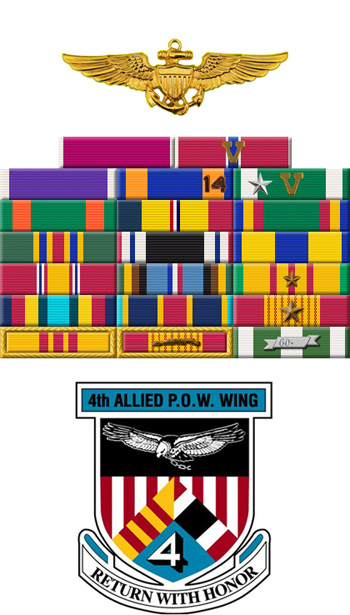
|
Henry D. Lesesne |
 |
|||
| Rank, Service | ||||
Captain O-6, U.S. Navy |
||||
| Veteran of: | ||||
|
||||
| Tribute: | ||||
Henry Lesesne was born in 1935 in Florence, South Carolina. He was commissioned through Naval Aviation Officer Candidate School on February 27, 1959, and was designated a Naval Aviator in April 1960. Ensign Lesesne was next assigned to the Replacement Air Group with VA-44 where he flew the A-1 Skyraider. He flew with VA-176 from January 1961 to February 1964, which included a deployment to stand alert during the Cuban Missile Crisis in 1963. From February 1964 to February 1967, he served as an instructor pilot with VT-7, and then transitioned to the A-4 Skyhawk. He flew with VA-81 from July 1967 to August 1969, and then flew with VA-44 as an instructor pilot in the A-4 Replacement Air Group from August 1969 to April 1970. From April 1970 to August 1971, LCDR Lesesne flew with VA-127. He transferred to VA-55 in August 1971, and began flying combat missions in Southeast Asia in February 1972. On July 11, 1972, LCDR Lesesne was forced to eject over North Vietnam and was taken as a Prisoner of War. He spent the next 261 days in captivity and was released during Operation Homecoming on March 29, 1973. After repatriation, Lesesne went back on flying status and flew the A-7 Corsair II, first with VA-122 from October 1973 to March 1975, and then with VA-113 from March 1975 to September 1977. Captain Lesesne served as Executive Officer and then Commanding Officer of VA-113 during this time. Lesesne next served in Carrier Task Group Operations in the Western Pacific including time as Commander Carrier Group Five, from September 1977 to August 1979. In August 1979 he transferred to the Chief of Naval Operations office, where he served in Detailed Program Analysis until August 1983. He then served with the Joint Chiefs of Staff from August 1983 until July 1984. His final assignment was as Deputy Director of the Fleet Operations and Readiness Division on the Staff of the Chief of Naval Operations from July 1984 until his retirement from the Navy on September 30, 1989. |
||||
|
||||

